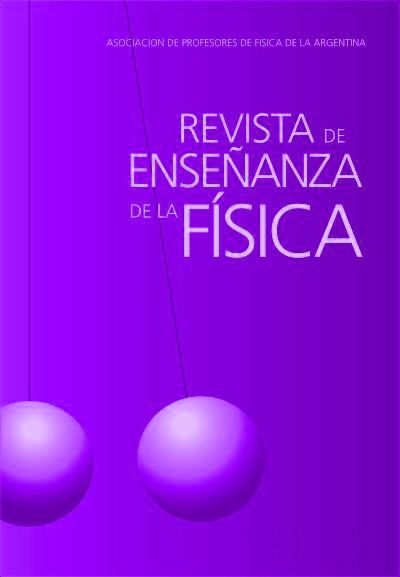Duality in the initial mechanics’ private knowledge: evidence from interviews
DOI:
https://doi.org/10.55767/2451.6007.v31.n1.24664Keywords:
Force Concept Inventory(FCI), Knowledge in pieces, CoherenceAbstract
It has been conjectured recently that initial private knowledge on mechanics has a dual structure, according to which predictions occur via fast, low cost operations, while explanations would employ a theory-like structure. Here we put to test that conjecture by direct search of evidence on the use of the fast resources, by interviewing five new university students (FCE UNLP) under an experimental test designed to that end. We found that fast resources are indeed used, which involve mainly dynamic visual simulations to a large extent subconscious, and that the outcome of those simulations determines the answers to predictions even if they are rationalized with conceptual argumentation. This results allow to understand certain apparently paradoxical aspects about the initial private knowledge and give a clue about how that knowledge can be restructured to result in expert private knowledge.References
Badagnani, D., Petrucci, D. y Cappannini, O. (2012). Sobre los recursos cognitivos en pensadores no-newtonianos, Actas del SIEF XI, http://hdl.handle.net/10915/
Badagnani, D., Petrucci, D. y Cappannini, O. (2018). Evidence on the coherence-pieces debate from the Force Concept Inventory. European Journal of Physics, 39(1), 015705.
Bao, L. y Redish, E. (2001). Model Analysis: Assessing the Dynamics of Student Learning http://arxiv.org/pdf/physics/0207069.pdf (Accessed 17 September 2014)
Clement, J. (2008). Creative model construction in scientists and students: the role of imagery, analogy and mental simulation. Dordrecht:Springer Netherlands.
diSessa, A. (2004). Coherence versus fragmentation in the development of the concept of force. Cogn. Sci., 28, 843-900.
Driver, R., Guesne, E. y Tiberghien, A. (1992). Ideas científicas en la infancia y la adolescencia. Madrid: Morata.
Halloun, I. A. y Hestenes, D. (1985). The initial knowledge state of college physics students. Am. J. Phys., 53, 1043-8.
Hammer, D., Elby, A., Scherr, R. E. y Redish, E. F. (2005). Resources, framing and transfer of Learning from a Modern Multidisciplinary Perspective. J. Mestre (Ed.) Greenwich, CT: Information Age Publishing, 89-120.
Hestenes, D., Wells, M. y Swackhamer, G. (1992). Force Concept Inventory. Physics Teacher, 30, 141-158.
Ionnides, C. y Vosniadou, S. (2002). The changing meaning of force. Cogn. Sci. Q., 2, 5-62.
Kahneman, D. (2011). Thinking, Fast and Slow. London: Macmillan.
Lasry, N., Rosenfield, S., Dedic, H., Dahan, A. y Reshef, O. (2011). The puzzling reliability of the force concept inventory. Am. J. Phys., 79, 909-12.
Lasry, N., Watkins, J., Mazur, E. y Ibrahim, A. (2013). Response times to conceptual questions. Am. J. Phys., 81, 703-6.
Redish, E. F. (2004). A theoretical framework for physics education research: modeling student thinking. Proc. 2004 Enrico Fermi Summer School, Course CLVI ed E Redish (Italian Physical Society), 1-63.
Sabella, M. S. y Redish, E. F. (2007). Knowledge activation and organization in physics problem-solving. Am. J. Phys., 75, 1017-29.
Özdemir, G. y Clark, D. (2007). An overview of conceptual change theories. Eurasia J. Math. Sci. Technol. Educ., 3, 351-61.
Pozo Municio, J. I. y Gómez Crespo, M. Á. (1998). Aprender y enseñar ciencia: del conocimiento cotidiano al conocimiento científico. Madrid: Morata.
Vosniadou, S. (Ed.). (2009). International handbook of research on conceptual change. Nueva York y Londres: Routledge.
Wood, A. K., Galloway, R. K. y Hardy, J. (2016). Can dual processing theory explain physics students’ performance on the force concept inventory? Phys. Rev. Phys. Educ. Res., 12, 023101.
Downloads
Published
Issue
Section
License
Copyright (c) 2019 Daniel Omar Badagnani

This work is licensed under a Creative Commons Attribution-NonCommercial-NoDerivatives 4.0 International License.
Aquellos autores/as que tengan publicaciones con esta revista, aceptan los términos siguientes:Los autores/as conservarán sus derechos de copiar y redistribuir el material, bajo los términos estipulados en la Licencia de reconocimiento, no comercial, sin obras derivadas de Creative Commons que permite a terceros compartir la obra bajo las siguientes condiciones:
- Reconocimiento — Debe reconocer adecuadamente la autoría, proporcionar un enlace a la licencia e indicar si se han realizado cambios. Puede hacerlo de cualquier manera razonable, pero no de una manera que sugiera que tiene el apoyo del licenciador o lo recibe por el uso que hace.
- NoComercial — No puede utilizar el material para una finalidad comercial.
- SinObraDerivada — Si remezcla, transforma o crea a partir del material, no puede difundir el material modificado.
- Los autores/as podrán adoptar otros acuerdos de licencia no exclusiva de distribución de la versión de la obra publicada (p. ej.: depositarla en un archivo telemático institucional o publicarla en un volumen monográfico) siempre que se indique la publicación inicial en esta revista.
- Se permite y recomienda a los autores/as difundir su obra a través de Internet (p. ej.: en archivos telemáticos institucionales o en su página web) antes y durante el proceso de envío, lo cual puede producir intercambios interesantes y aumentar las citas de la obra publicada. (Véase El efecto del acceso abierto).










